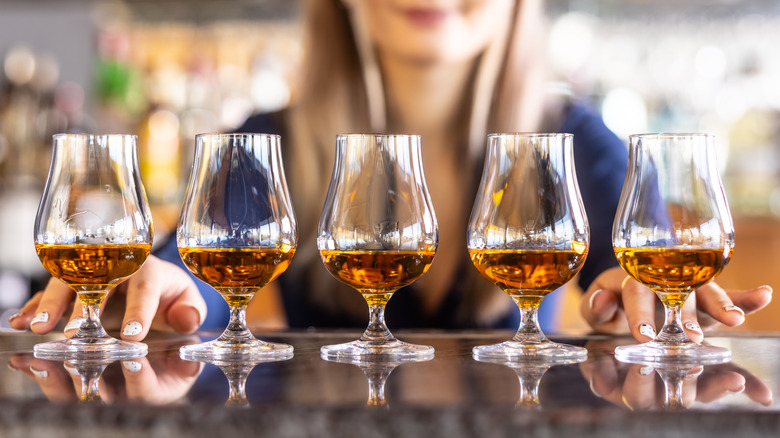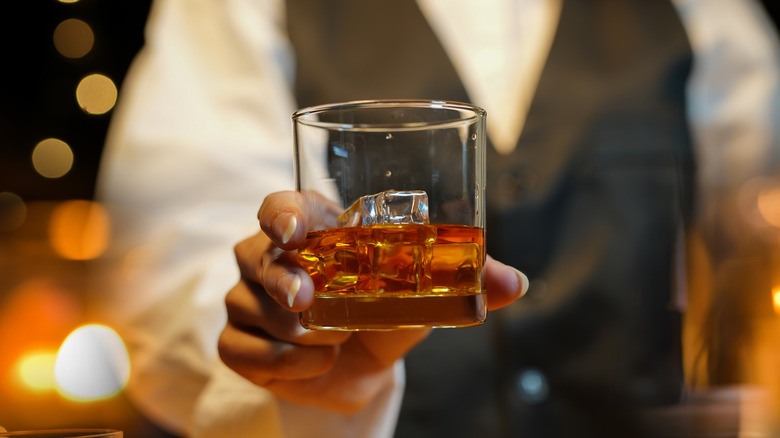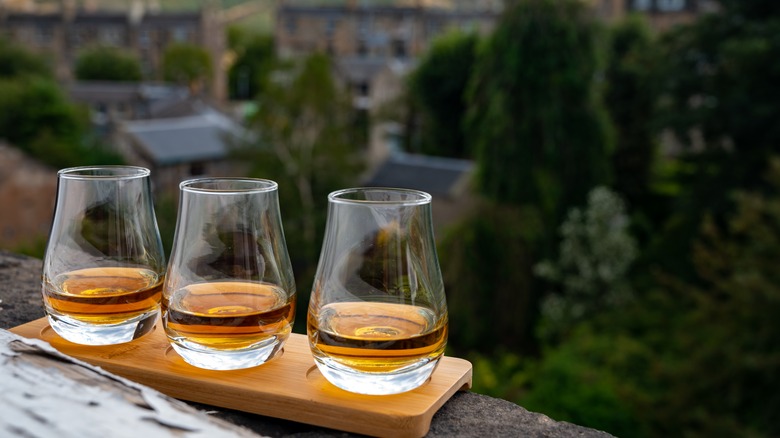The Whiskey Tasting Faux Pas That Will Make Your Bartender Cringe
Attending a whiskey tasting isn't the same as going out for drinks with friends. It doesn't need to have the semblance of a stuffy high-class gala, but there is a purpose to the event that requires a little more discipline than attending a friendly get-together. The whole point is to become more knowledgeable about the subtle nuances different varieties exhibit and taste the whiskey like a pro. With that in mind, there are certain practices you want to observe during a tasting that contrast with a typical night out on the town.
Chris Blatner is an executive bourbon steward and the creator of @urbanbourbonist on Instagram. He recently gave Foodie exclusive tips on how to make the most out of a whiskey tasting. One of the first things he notes is that whiskey (not the same as "whisky") shouldn't be downed like a shot. If the liquor is passing your tongue and going straight down your throat, the delicate flavor differences between brands will be lost. "If you are doing a tasting, it's best to take smaller sips and allow the whiskey to coat your entire mouth and palate to get the full experience," Blatner explains. Ordering a flight and pounding the drinks like you're in your college prime only serves to intoxicate you and make your bartender roll their eyes.
Awaken your palate before tasting whiskey
According to Chris Blatner, warming up your palate prior to a tasting is crucial. "Acclimating your palate to alcohol and the flavors of whiskey will help you to discern flavors and enjoy a tasting much more," he says. The brown booze has a notoriously intense bite, and taking a sip of it before preparing your taste buds can be a shock that makes you wince. That rush will impact your ability to identify the subtle flavors lingering in the liquor.
Your tongue has around 10,000 pores that should be opened before a tasting to fully appreciate all the refined differences between various types of whiskey. Some suggest drinking a light, un-hoppy beer to wake the palate up. Others recommend ordering a highball cocktail to get things started. Perhaps the most common recommendation to prepare your mouth for tasting whiskey is by... drinking whiskey. A familiar, low ABV (alcohol by volume) brand should acclimate your palate to the powerful smack of alcohol and allow it to pick up on the sophisticated nuances of the whiskies you want to know more about.
When it comes to new whiskies, keep an open mind
One of the most critical mistakes many make when tasting whiskey is having preconceived notions about what they are going to sample. Whether it's a whiskey you've had previously and didn't care for or just something you've heard about a particular variety, don't judge it before you try it. As Chris Blatner puts it, "Palates change all the time, and something you disliked before may taste good to you now. And the same goes for things that you liked before; You may not like them now."
Our taste buds regenerate about every two weeks, but the mind plays a pivotal role in how we perceive the flavors of everything that goes into our mouths. If you had a lousy time from drinking too much whiskey in your glory days, that encounter may influence the way you react to the flavor today. Try to set aside any grudges you may hold against the spirit and keep an open mind. Your taste preferences aren't set in stone, and being able to identify the subtle differences between whiskies can be a rewarding experience.


